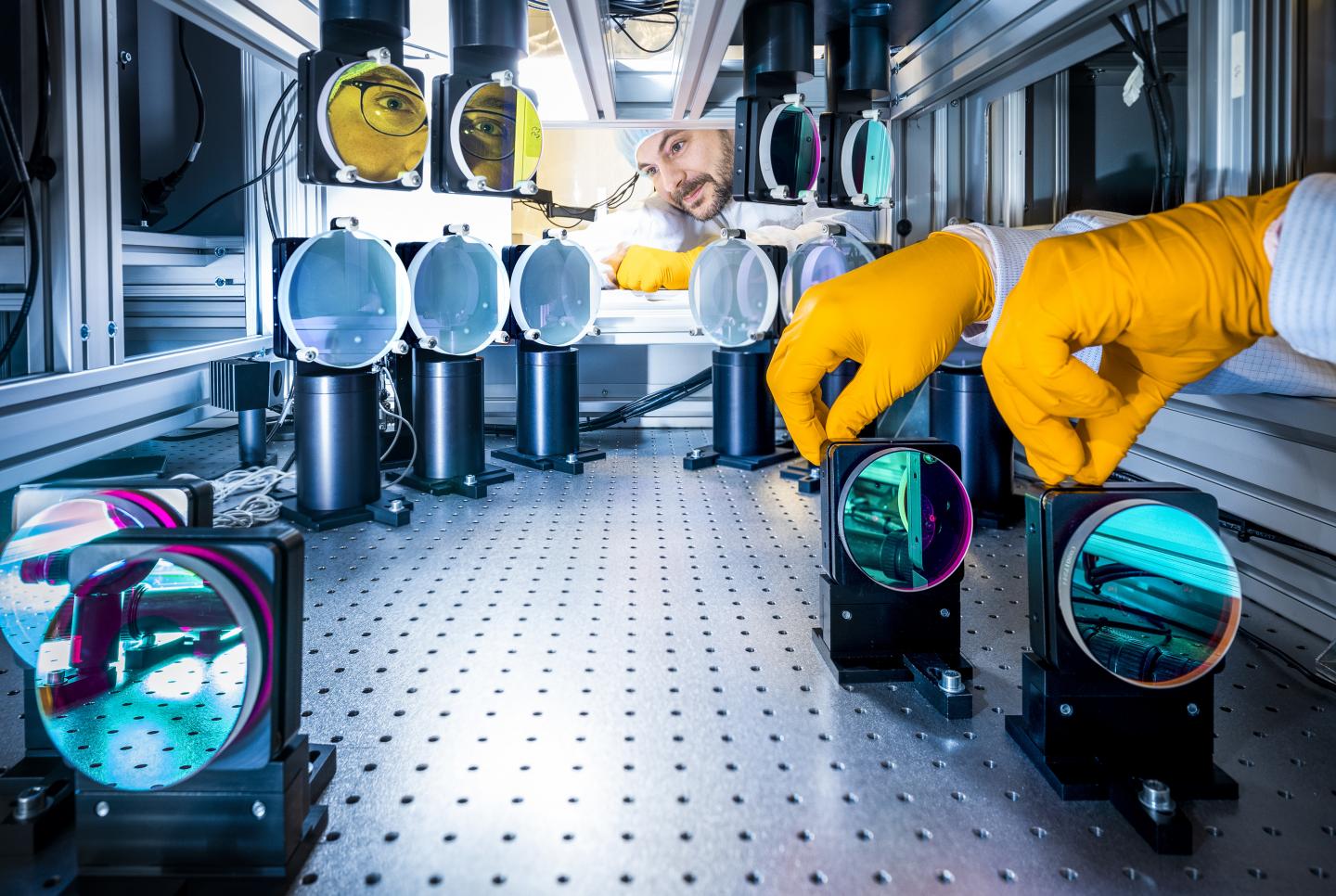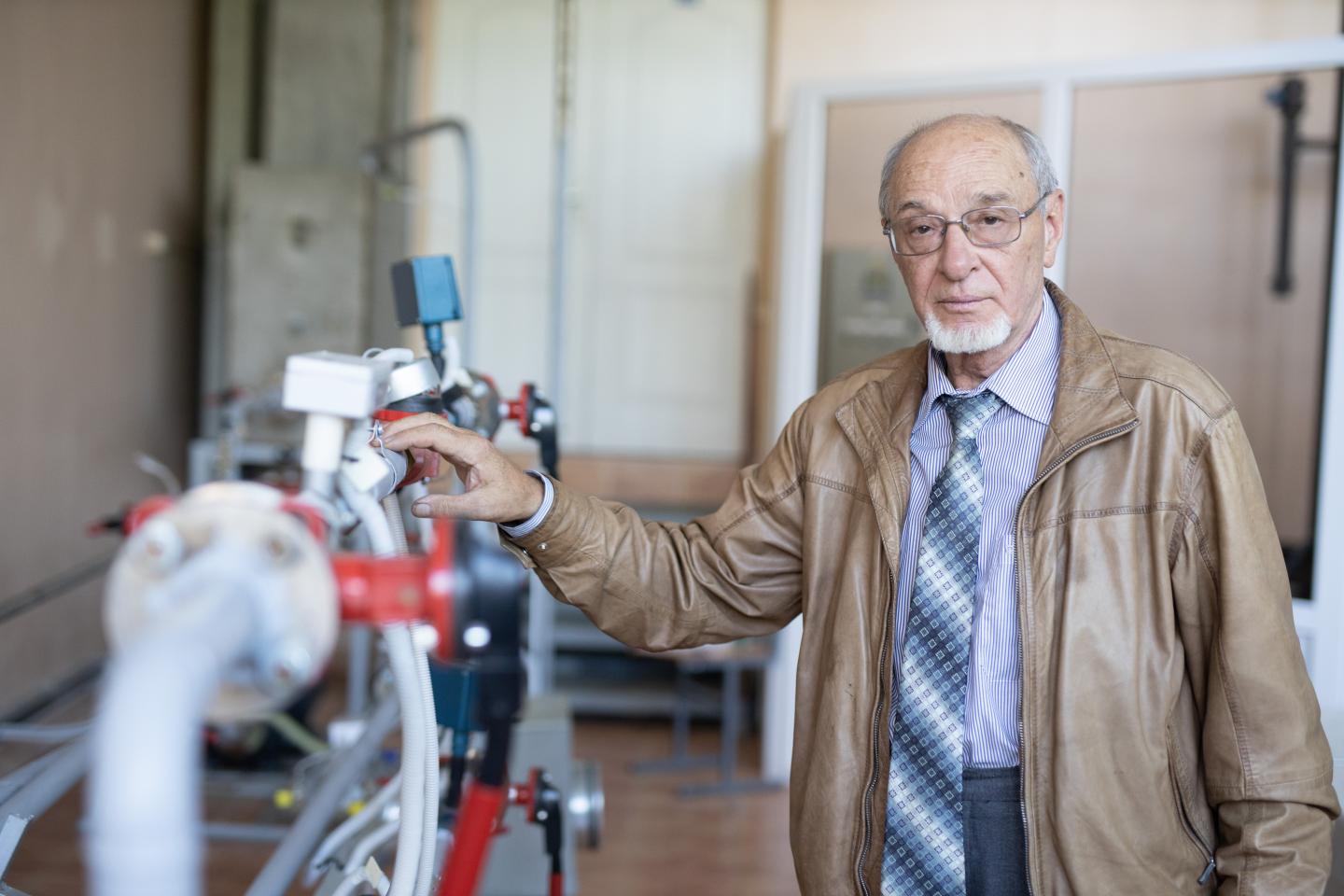Researchers reporting in ACS’ Environmental Science & Technology have observed that non-biting midge larvae accumulate contemporary pesticides from polluted water and retain the substances into adulthood. As a result, animals that eat the adult flies could consume small amounts of pesticides daily.
Tag: Chemistry
Waste coffee grounds could someday help detect brain waves
There’s nothing like a cuppa to give your morning a boost. Researchers report the first use of waste coffee grounds as electrode coatings for sensitive neurochemistry measurements, which could help scientists get a better handle on brain activity. They will present their results at ACS Spring 2022.
Meet VMS – the briefcase-sized chemistry lab headed to Venus
Short for Venus Mass Spectrometer, VMS is one of five instruments aboard the DAVINCI descent probe.
Converting Methane to Methanol — With and Without Water
UPTON, NY — Chemists have been searching for efficient catalysts to convert methane — a major component of abundant natural gas — into methanol, an easily transported liquid fuel and building block for making other valuable chemicals. Adding water to the reaction can address certain challenges, but it also complicates the process.
Sweat-collecting patch inspired by cactus spines
A sweat-collecting patch has been developed using the principle based on how the cactus spines attract water.
Energy Secretary, Washington Governor Dedicate Energy Sciences Center at PNNL
Fundamental research conducted at the $90-million research facility will help the nation meet its clean energy goals.
Imaging the Chemical Fingerprints of Molecules
Experiment, theory, and simulation show basic chemical properties are imprinted in atomic force microscope images and may help ID unknown molecules.
Scientists find strange black ‘superionic ice’ that could exist inside other planets
Scientists have discovered a way to recreate the ice that exists inside planets like Neptune and Uranus, ice which forms at extremely high temperatures and pressures.
Not so Basic: Advances in pH and Phosphate Monitoring Enhance Safety in Nuclear Fuel Recycling
Two PNNL interns are behind recent innovation in real-time testing and continuous monitoring for pH and the concentration of chemicals of interest in chemical solutions; outcomes have applicability not only to nuclear, but to industries.
Science snapshots from Berkeley Lab
New Berkeley Lab breakthroughs: engineering chemical-producing microbes; watching enzyme reactions in real time; capturing the first image of ‘electron ice’; revealing how skyrmions really move
Avoiding an Energy Cold Crunch with More Efficient Cooling
Covalent organic polymers can adsorb three times more refrigerant than the best available alternatives, resulting in more efficient cooling.
2021 Blavatnik Regional Awards for Young Scientists Honorees Announced During National Postdoc Appreciation Week
Honoring outstanding postdoctoral scientists from across New York, New Jersey, and Connecticut, the 2021 Blavatnik Regional Awards for Young Scientists announces the Winners and Finalists during National Postdoc Appreciation Week.
Cao receives Young Investigator Award from American Chemical Society
Pengfei Cao, a polymer chemist at the Department of Energy’s Oak Ridge National Laboratory, has been chosen to receive a 2021 Young Investigator Award from the Polymeric Materials: Science and Engineering Division of the American Chemical Society.
$1.9M NSF-funded initiative to transform UIC undergraduate chemistry offerings
Supported by a five-year, $1.9 million grant from the National Science Foundation, the University of Illinois Chicago department of chemistry will launch a project consisting of evidence-based research of teaching and learning practices, course and curriculum revisions and faculty development, all with the intention of enhancing STEM education for undergraduate students.
In a first, scientists capture a ‘quantum tug’ between neighboring water molecules
Researchers have made the first direct observation of how hydrogen atoms in water molecules tug and push neighboring water molecules when they are excited with laser light.
Phosphorescent material inspired by ‘glow in the dark’ wood
Scientists have harnessed the natural ability of wood to faintly glow to develop a new sustainable phosphorescent material that could potentially be used in a wide number of applications, from medical imaging and optical sensing to ‘glow in the dark’ dyes and paints.
To Reduce Vehicle Pollution, a Single Atom Can Do the Work of Several
A discovery from PNNL and Washington State University could help reduce the amount of expensive material needed to treat vehicle exhaust by making the most of every precious atom.
Green Diesel for the Road Ahead
A new report led by PNNL identifies the top 13 most promising waste- and biomass-derived diesel blendstocks for reducing greenhouse gas emissions, other pollutants, and overall system costs.

Wayne State researcher awarded $3.3 million from DOE to advance quantum science and technology
The U.S. Department of Energy (DOE) announced recently $73 million in funding to advance quantum information science research to aid in better understanding the physical world and harness nature to benefit people and society. Aaron Rury, Ph.D., assistant professor of chemistry in Wayne State’s College of Liberal Arts and Science, is the recipient of one of 29 projects funded by the DOE.
David Chavez selected Fellow of the American Chemical Society
David Chavez, deputy group leader of the High Explosives Science and Technology group at Los Alamos National Laboratory, has been selected as a member of the 2021 class of Fellows of the American Chemical Society (ACS).
Michael S. Arnold: Then and Now / 2011 Early Career Award Winner
Supported by his Early Career Research Program Award, University of Wisconsin – Madison professor Michael S. Arnold found new ways to make graphene nanostructures with smooth edges. This technology will enable next-generation energy and electronics applications.
Bottling Clean Energy in Chemical Bonds
Of the various methods to store renewable energy, one stands out for holding onto energy for months at a time: storing energy in the chemical bonds of molecules such as hydrogen.
DOE Announces $73 Million for Research to Advance Quantum Science and Technology
The U.S. Department of Energy (DOE) announced $73 million in funding to advance quantum information science (QIS) research to help scientists better understand the physical world and harness nature to benefit people and society.
Department of Energy awards $4.15 million to Argonne to support collaborations with industry
The U.S. Department of Energy has awarded $4.15 million to Argonne National Laboratory to support collaborations with industry aimed at commercializing promising energy technologies.

Antimatter From Laser Pincers
In the depths of space, there are celestial bodies where extreme conditions prevail: Rapidly rotating neutron stars generate super-strong magnetic fields.

Scientists Offered Using Methanol in Power Generation for Electric Cars
Professors at Ural Federal University (UrFU, Russia) Sergey Shcheklein and Aleksey Dubinin have developed a technology for generating energy for an electric car engine using methanol. An article describing the technology was published in the International Journal of Hydrogen Energy.

UCI scientists make X-ray vision-like camera to rapidly retrieve 3D images
Irvine, Calif., July 21, 2021 — It’s not exactly X-ray vision, but it’s close. In research published in the journal Optica, University of California, Irvine researchers describe a new type of camera technology that, when aimed at an object, can rapidly retrieve 3D images, displaying its chemical content down to the micrometer scale.

Capturing Electrons in Space
Interstellar clouds are the birthplaces of new stars, but they also play an important role in the origins of life in the Universe through regions of dust and gas in which chemical compounds form.
Main Attraction: Scientists Create World’s Thinnest Magnet
Scientists at Berkeley Lab and UC Berkeley have created an ultrathin magnet that operates at room temperature. The ultrathin magnet could lead to new applications in computing and electronics – such as spintronic memory devices – and new tools for the study of quantum physics.
Bio-based coating for wood outperforms traditional synthetic options
Researchers have used lignin, a natural polymer abundant in wood and other plant sources, to create a safe, low-cost and high-performing coating for use in construction. The coating is non-toxic, hydrofobic, it retains wood’s breathability and natural roughness while being resistant to colour changes and abrasion.
Tiny but mighty precipitates toughen a structural alloy
Scientists at Oak Ridge National Laboratory and the University of Tennessee, Knoxville, have found a way to simultaneously increase the strength and ductility of an alloy by introducing tiny precipitates into its matrix and tuning their size and spacing.
EMBARGOED: Protocells spring into action
A University of Bristol-led team of international scientists with an interest in protoliving technologies, has today published research which paves the way to building new semi-autonomous devices with potential applications in miniaturized soft robotics, microscale sensing and bioengineering.
No lab required: New technology can diagnose infections in minutes
Engineering, biochemistry and medical researchers from McMaster University have created a hand-held rapid test for bacterial infections that can produce accurate, reliable results in less than an hour, eliminating the need to send samples to a lab.
Protocells spring into action
A University of Bristol-led team of international scientists with an interest in protoliving technologies, has today published research which paves the way to building new semi-autonomous devices with potential applications in miniaturized soft robotics, microscale sensing and bioengineering.
Scientists obtain magnetic nanopowder for 6G technology
Material scientists have developed a fast method for producing epsilon iron oxide and demonstrated its promise for next-generation communications devices. Its outstanding magnetic properties make it one of the most coveted materials, such as for the upcoming 6G generation of communication devices and for durable magnetic recording. The work was published in the Journal of Materials Chemistry C, a journal of the Royal Society of Chemistry.
Department of Energy Announces $28.9 Million for Research to Develop Advanced Chemical Sciences Software
Today, the U.S. Department of Energy (DOE) announced $28.9 million in funding for nine research projects to advance the development of sophisticated software for the chemical sciences.
Bio-inspired hydrogel protects the heart from post-op adhesions
A hydrogel that forms a barrier to keep heart tissue from adhering to surrounding tissue after surgery was developed and successfully tested in rodents by a team of University of California San Diego researchers. The team of engineers, scientists and physicians also conducted a pilot study on porcine hearts, with promising results.
They describe their work in the June 18, 2021 issue of Nature Communications.
Driving clean-energy research in the right direction
Fuel cells, part of a promising path toward zero-emission vehicles, are making progress at overcoming some specific challenges on the road to powering heavy-duty vehicles.
Saint Louis University Student Searches for Possible Origins of Life on Saturn’s Largest Moon
Chemistry grad student Steven Skaggs was recently selected for funding by the Future Investigators in NASA Earth and Space Science and Technology (FINESST) program.
Blavatnik Family Foundation, New York Academy of Sciences Name 31 Finalists for 2021 Blavatnik National Awards for Young Scientists
The 2021 Blavatnik National Awards today named 31 finalists for the world’s largest unrestricted prize honoring early-career scientists. The finalists were culled from 298 nominations by 157 U.S. research institutions across 38 states. They have made trailblazing discoveries in wide-ranging fields, from the neuroscience of addiction to the development of gene-editing technologies, from designing next-generation battery storage to understanding the origins of photosynthesis, from making improvements in computer vision to pioneering new frontiers in polymer chemistry.
A Keen Eye Behind the Microscope
PNNL’s Dongsheng Li’s crystal formation research helped reveal why nanoparticles sometimes self-assemble into five-sided shapes. The discovery will potentially be useful in medical research, electronics, and other applications.
Capturing the Chemistry of Light-Activated Cancer Drugs with Ruomei Gao
Ruomei Gao—an associate professor at SUNY College at Old Westbury—has been using facilities at the Center for Functional Nanomaterials at Brookhaven Lab to investigate two primary processes of photosensitization for cancer therapy and prevention.
DOE scientists deploy creativity, speed to disrupt COVID-19
An ORNL-led team comprising researchers from multiple DOE national laboratories is using artificial intelligence and computational screening techniques – in combination with experimental validation – to identify and design five promising drug therapy approaches to target the SARS-CoV-2 virus.
Key to Carbon-Free Cars? Look to the Stars
In a decade-long quest, scientists at Berkeley Lab, the University of Hawaii, and Florida International University uncover new clues to the origins of the universe – and land new chemistry for cleaner combustion engines
Clean Water for All
New research findings aid in the design of more efficient water purification technologies.
Are Heavy Metals Toxic? Scientists Find Surprising New Clues in Yeast
Scientists at Berkeley Lab and UC Berkeley have compiled the most complete library yet of lanthanide heavy metals and their potential toxicity – by exposing baker’s yeast to lanthanides. Their findings could help researchers uncover hidden pathways between lanthanide metals and disease.
Scientists Discover New Approach to Stabilize Cathode Materials
UPTON, NY—A team of researchers led by chemists at the U.S. Department of Energy’s (DOE) Brookhaven National Laboratory has studied an elusive property in cathode materials, called a valence gradient, to understand its effect on battery performance. The findings, published in Nature Communications, demonstrated that the valence gradient can serve as a new approach for stabilizing the structure of high-nickel-content cathodes against degradation and safety issues.
NUS researchers develop novel technique to automate production of pharmaceutical compounds
Giving a new spin to conventional chemical synthesis, a team of researchers from the National University of Singapore (NUS) has developed a way to automate the production of small molecules suitable for pharmaceutical use. The method can potentially be used for molecules that are typically produced via manual processes, thereby reducing the manpower required.
A new ‘gold standard’ compound for generating electricity from heat
Researchers show in a new study that a single material, a layered crystal consisting of the elements rhenium and silicon, turns out to be the gold standard of transverse thermoelectric devices.
Surge in Nitrogen Has Turned Sargassum into the World’s Largest Harmful Algal Bloom
Scientists have discovered dramatic changes in the chemistry and composition of Sargassum, floating brown seaweed, transforming this vibrant living organism into a toxic “dead zone.” Results suggest that increased nitrogen availability from natural and anthropogenic sources, including sewage, is supporting blooms of Sargassum and turning a critical nursery habitat into harmful algal blooms with catastrophic impacts on coastal ecosystems, economies, and human health. Globally, harmful algal blooms are related to increased nutrient pollution.